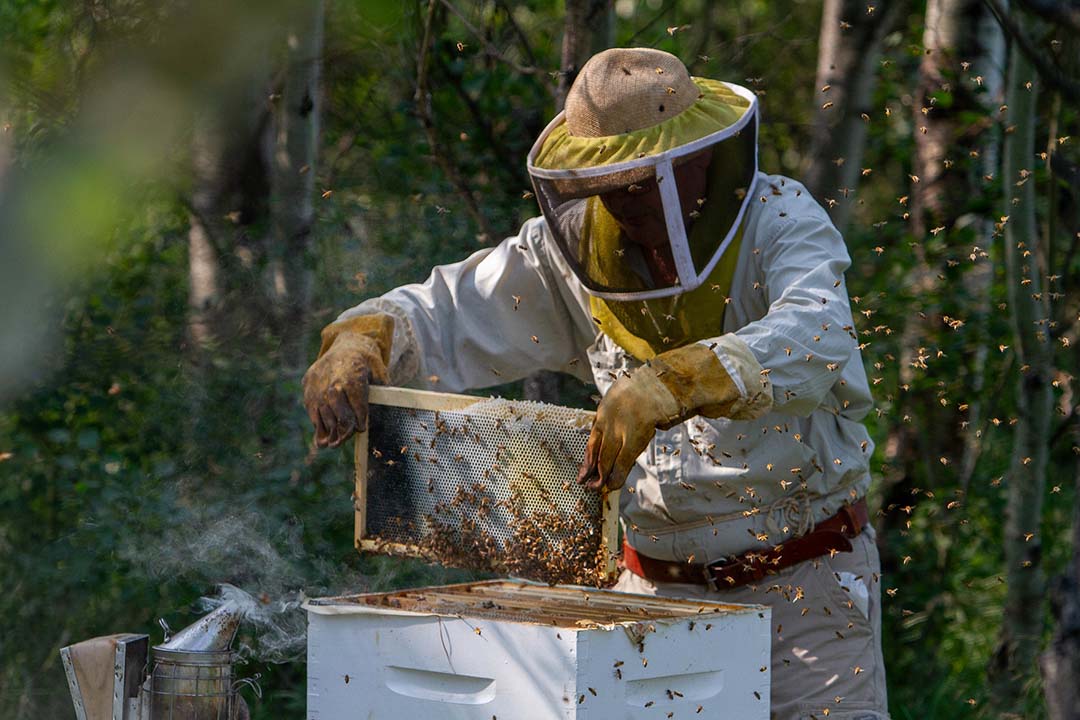
USask researcher uses honey bees to study fetal alcohol spectrum disorder
Bees share a surprising number of similarities to humans, in both their biology and their social structure.
By Matt Olson, Research Profile and ImpactOne University of Saskatchewan (USask) researcher believes that because of these similarities, honey bees can be used as a model to study the effects of fetal alcohol spectrum disorder (FASD).
“Honey bees have tremendously sophisticated social behaviour that is in some ways similar to our behaviour as humans,” said Dr. Sarah Wood (DVM, PhD), associate professor at USask’s Western College of Veterinary Medicine. “Some of the clinical signs of FASD include deficits in social behaviour, so honey bees may make a great model for this disorder.”
FASD is a condition affecting individuals who were exposed to alcohol before birth, and while it can have both physical and mental impacts, it is a disorder that can be difficult to accurately diagnose. Wood said she was inspired by the use of honey bees in previous research to study autism, due to the social nature of bees and of the disorder.
The project received support from the Saskatchewan Health Research Foundation (SHRF) Establishment Grant program, intended to support early-career researchers in building their research programs. Wood and graduate student Maria Janser will be running the project.
“The support from SHRF is incredibly important,” Wood said. “Health science research is new to me, and to be exploring honey bees as models for human disease is an exciting opportunity to expand our research impact.”
By introducing ethanol to bee larvae in their diet in the laboratory and raising them into adult bees before re-introducing them into the hive setting, researchers will study bee social behaviours as well as the genetics of the alcohol-exposed bees to get a fuller understanding of FASD in bees as a model for humans.
Wood identified honey bees as “eusocial” organisms — creatures that have achieved the highest levels of organization and sociality as a species, like ants and termites. Eusociality can be identified through three main characteristics: overlapping generations of parents and children living together, co-operative brood care where individuals in the community care for their young, and the division of labour among individuals. Humans also display some eusocial traits, even though they are not considered a eusocial species.
These similar attributes make honey bees a strong model for conducting behavioural assays to study the social effects of FASD in people.
“There’s a lot of comparable behaviours that we can study in both bees and humans,” Wood said. “There are lots of animal models for FASD, but most of them do not display a wide range of social behaviours. Through glass-sided observation hives, we can observe how honey bee adults interact with their nestmates, their queen, and their young brood, and we can compare how developmental ethanol exposure influences their social behaviours.”
In addition to behavioural assessments, Wood will examine gene expression in the brain of alcohol-exposed bees. Wood hopes to identify genetic pathways in the brains of ethanol-exposed bees distinct from the control group, which will give insights into the genetic pathways affected in the human brain as well.
Wood said there is a significant amount of stigma that still comes with talking about FASD and its ramifications. She hopes this FASD study through honey bees can help remove or circumvent some of that stigma, and that in the future bees could be considered models for testing pharmaceuticals meant for FASD as well.
“Honey bees are a charismatic and engaging species for the public and especially for children,” she said. “If we can connect a stigmatized condition with an animal model that is positive and engaging, maybe we can open up more constructive conversations about supporting families affected by FASD in our communities.”
The following USask projects also received funding in the most recent round of SHRF Establishment grants
Dr. Bryce Warner (PhD), Vaccine and Infectious Disease Organization (VIDO) – Using novel cell culture and animal models to identify the drivers of disease in hantavirus cardiopulmonary syndrome – $149,564
Dr. Olamide Adebiyi (PhD, DVM), Western College of Veterinary Medicine (WCVM) – Stimulating the activity of neurons to restore myelin and improve cognition in mouse models of multiple sclerosis – $150,000
Dr. Tyler Wenzel (PhD), College of Medicine – Developing a new technique to cure brain diseases with limited or no safe treatment options – $150,000
Dr. Tracey Carr (PhD), College of Medicine – How to keep family physicians in rural and remote Saskatchewan communities – $150,000
Dr. Barbara Fornssler (PhD), School of Public Health – Creating a substance use data ecology for Saskatchewan to improve pathways of care – $149,990
Dr. Thilina Bandara (PhD), School of Public Health – The public health system in Saskatoon – $145,100

